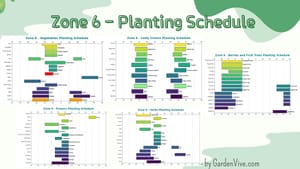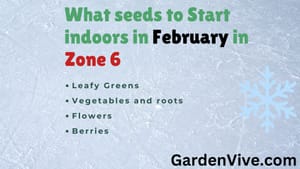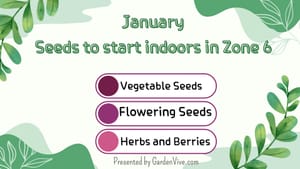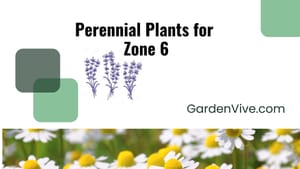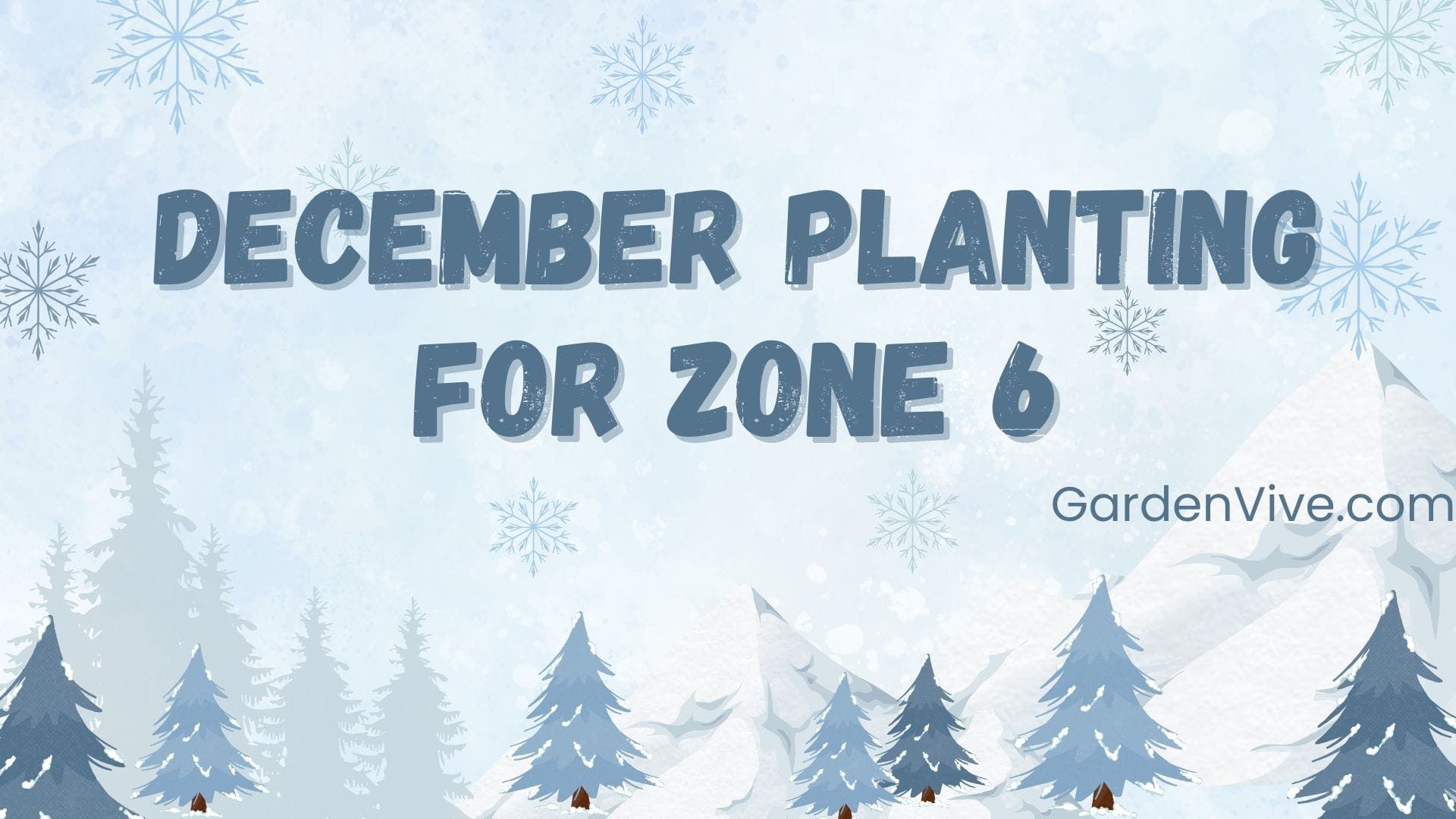
The average minimum temperature in USDA Zone 6 is -10°F to 0°F. Pretty cold right? From November, you can sense the climate leaning towards cold and December is pretty cold out here. But don't worry, we have plenty of plants to plant in December. This tutorial is all about what you can plant in December in Zone 6.
Last month, I published the November planting guide for Zone 6. I promised I would be back with the December planting guide and here I am.
If I consider the average first frost date, then the first frost should be already done and we can choose hardy plants for our December planting that can survive in extreme cold.
December planting guide - Zone 6
I have seen a few gardeners who intend to skip the winter planting due to the harsh cold climate. To make your garden productive and maintain continuity, you should consider winter gardening.
Mother nature is really amazing as it allows us to grow different types of plants in different climates. It's a wise decision to take this advantage.
Those who are following my planting guides, already know that I create lists of plants and separate those into major categories like veggies/roots, flowering plants, herbs, etc. It helps my readers to choose the plants according to their gardening style.
I am mentioning the planting methods, spacing, variety suggestions, and other essential information beside each plant name. Make sure to scroll the tables side-wise on mobile devices not to miss any information.
Leafy Greens
| Plant Name | Planting Method | Spacing | Variety Suggestion | Harvesting Time (Days) | Frost Caring |
|---|---|---|---|---|---|
| Spinach | Direct seed sowing | 4-6 inches apart | ‘Bloomsdale,’ ‘Winter Bloomsdale’ | 35-50 days | Use row covers or cold frames |
| Kale | Transplanting | 12-18 inches apart | ‘Winterbor,’ ‘Red Russian’ | 50-70 days | Mulch heavily and use frost cloth |
| Arugula | Direct seed sowing | 4-6 inches apart | ‘Astro,’ ‘Rocket’ | 20-40 days | Use row covers during extreme frost |
| Winter Lettuce | Transplanting | 8-12 inches apart | ‘Winter Density,’ ‘Merveille des Quatre Saisons’ | 45-60 days | Cold frames or hoop tunnels |
| Swiss Chard | Direct seed sowing | 8-12 inches apart | ‘Fordhook Giant,’ ‘Bright Lights’ | 50-60 days | Mulch and cover with frost cloth |
| Mâche (Corn Salad) | Direct seed sowing | 4-6 inches apart | ‘Vit,’ ‘Verte de Cambrai’ | 40-50 days | Cold frames or plastic tunnels |
| Mustard Greens | Direct seed sowing | 6-12 inches apart | ‘Southern Giant Curled,’ ‘Red Giant’ | 30-45 days | Use frost cloth for extended protection |
If you are not an expert gardener, ignore corn salad and mustard greens. There is no harm in trying but they will need extreme care.
Roots and Vegetables
Growing roots and vegetables in December is not as easy as in warmer months. But it's better to give it a try. Nothing to lose but you will definitely gain experience and some fresh harvesting as well.
| Vegetable Name | Planting Method | Spacing | Variety Suggestion | Harvesting Time (Days) | Frost Caring |
|---|---|---|---|---|---|
| Carrots | Direct seed sowing | 2-4 inches apart | ‘Napoli,’ ‘Mokum’ | 60-80 days | Mulch heavily and use row covers |
| Radishes | Direct seed sowing | 1-2 inches apart | ‘French Breakfast,’ ‘Watermelon’ | 20-30 days | Protect with cold frames |
| Turnips | Direct seed sowing | 4-6 inches apart | ‘Purple Top White Globe,’ ‘Hakurei’ | 30-60 days | Use straw mulch for insulation |
| Parsnips | Direct seed sowing | 6-8 inches apart | ‘Hollow Crown,’ ‘Gladiator’ | 95-120 days | Mulch and allow frost for sweeter flavor |
| Garlic | Clove planting | 4-6 inches apart | ‘Music,’ ‘German White’ | 180-210 days | Mulch heavily and keep soil moist |
| Onions | Transplanting | 4-6 inches apart | ‘Walla Walla,’ ‘Yellow Sweet Spanish’ | 90-120 days | Use row covers for young plants |
| Beets | Direct seed sowing | 3-4 inches apart | ‘Detroit Dark Red,’ ‘Golden’ | 50-70 days | Protect with row covers or mulch |
| Rutabagas | Direct seed sowing | 6-8 inches apart | ‘American Purple Top,’ ‘Joan’ | 80-100 days | Apply straw mulch for frost protection |
Flowering Plants
| Plant Name | Planting Method | Spacing | Variety Suggestion | Blooming Season | Flower Color | Frost Caring |
|---|---|---|---|---|---|---|
| Hellebores (Lenten Rose) | Transplanting | 12-18 inches apart | ‘Winter Sunshine,’ ‘Ivory Prince’ | Late winter to early spring | White, pink, purple | Mulch heavily to protect roots |
| Snowdrops | Bulb planting | 3-4 inches apart | ‘Galanthus nivalis,’ ‘Flore Pleno’ | Late winter | White | Plant in well-drained soil with mulch |
| Crocus | Bulb planting | 3-6 inches apart | ‘Ruby Giant,’ ‘Yellow Mammoth’ | Late winter to early spring | Purple, yellow, white | Cover with straw mulch during hard frosts |
| Winter Aconites | Bulb planting | 3-4 inches apart | ‘Eranthis hyemalis’ | Late winter | Yellow | Use mulch to insulate bulbs |
| Primroses | Transplanting | 6-12 inches apart | ‘English Primrose,’ ‘Drumstick’ | Early spring | Varied (yellow, red, blue, pink) | Cold frames or frost cloth |
| Pansies | Transplanting | 6-8 inches apart | ‘Matrix,’ ‘Cool Wave’ | Winter to spring | Varied (yellow, purple, white) | Cover with row covers in deep frost |
| Violas | Transplanting | 6-8 inches apart | ‘Johnny Jump Up,’ ‘Penny’ | Winter to early spring | Varied (yellow, purple, blue) | Protect with mulch in cold snaps |
Plant crocus bulbs at least 3-4 inches deep as well. The pointed end of the bulb should face upward. ( Same for Winter Aconites)
To make the soil and roots warmer, adding mulch is a good decision. It works like an insulator.
Those who are interested in growing perennial plants can read: Perennial Plants for Zone 6
Herbs
| Herb Name | Planting Method | Spacing | Variety Suggestion | Growth Season | Uses | Frost Caring |
|---|---|---|---|---|---|---|
| Thyme | Transplanting or direct sowing | 8-12 inches apart | ‘English Thyme,’ ‘Lemon Thyme’ | Winter-hardy; grows year-round in mild areas | Culinary and medicinal | Mulch around the base and cover with a frost cloth |
| Chives | Transplanting or direct sowing | 6-8 inches apart | ‘Common Chives,’ ‘Garlic Chives’ | Early spring growth from overwintered roots | Culinary garnishes and pest deterrent | Cover with straw mulch for insulation |
| Sage | Transplanting | 12-18 inches apart | ‘Garden Sage,’ ‘Purple Sage’ | Evergreen; produces year-round in mild climates | Culinary, medicinal, and ornamental | Mulch heavily to prevent root freezing |
| Parsley | Direct sowing or transplanting | 6-8 inches apart | ‘Flat-Leaf,’ ‘Curly Leaf’ | Winter-hardy; slow growth in colder months | Culinary and garnish | Protect with row covers or plant indoors |
| Rosemary | Transplanting | 18-24 inches apart | ‘Arp,’ ‘Tuscan Blue’ | Evergreen; year-round in protected conditions | Culinary and ornamental | Bring indoors or grow in pots; cover during frost |
| Dill | Direct sowing | 10-12 inches apart | ‘Bouquet,’ ‘Fernleaf’ | Late winter to early spring | Culinary and pickling | Use a cold frame for winter sowing |
| Mint | Transplanting | 12-18 inches apart | ‘Peppermint,’ ‘Spearmint’ | Spring growth from overwintered roots | Culinary, medicinal, and teas | Cover with mulch or grow indoors |
| Oregano | Transplanting or direct sowing | 12-18 inches apart | ‘Greek Oregano,’ ‘Italian Oregano’ | Winter-hardy; slow growth in cold months | Culinary and medicinal | Mulch around the base and protect with row covers |
You can also plant English Lavender such as 'Munstead' or 'Hidcote,' as these are better suited for colder climates.
My suggestion is to avoid tender varieties like Spanish or French lavender unless you plan to grow them in pots indoors.
For flowering plants and herbs, it's best to plant those in pots or containers in December. You can bring them outside in the daytime to give them direct sunlight and bring them back indoors before the evening. I know it's a lot of work but it will be worth doing so.
Berries
| Berry Name | Planting Method | Variety Suggestion | Max Height | Taste/Flavor | Frost Caring |
|---|---|---|---|---|---|
| Strawberry | Transplanting | ‘June-bearing,’ ‘Everbearing’ | 6-12 inches | Sweet and tangy | Mulch around the base to protect from cold |
| Raspberry | Transplanting | ‘Red Heritage,’ ‘Autumn Bliss’ | 3-5 feet | Sweet and tart | Use row covers or mulch for frost protection |
| Blackberry | Transplanting | ‘Natchez,’ ‘Triple Crown’ | 4-6 feet | Sweet and juicy | Protect with mulch or row covers during extreme cold |
| Goji Berry | Transplanting | ‘Phoenix Tears,’ ‘Superfruit’ | 5-8 feet | Slightly sweet, tangy | Protect roots with mulch and cover young plants |
| Blueberry | Transplanting | ‘Legacy,’ ‘Bluecrop’ | 2-4 feet | Sweet and tart | Mulch to protect roots from frost |
| Currant | Transplanting | ‘Red Lake,’ ‘Blackdown’ | 3-4 feet | Tart, slightly sweet | Mulch around the plant for winter protection |
In colder months, we face fewer pests and bugs which is a positive point for winter gardening.
Request to my readers
As days are passing, I am becoming more serious in creating planting guides that will actually help Zone 6 gardeners. So what motivates me to write more? The answer is "You!" I can check how many gardeners are reading my articles. It takes a lot of time to create this type of articles. If possible share this to other Zone 6 gardeners and subscribe to this site. It's free!

